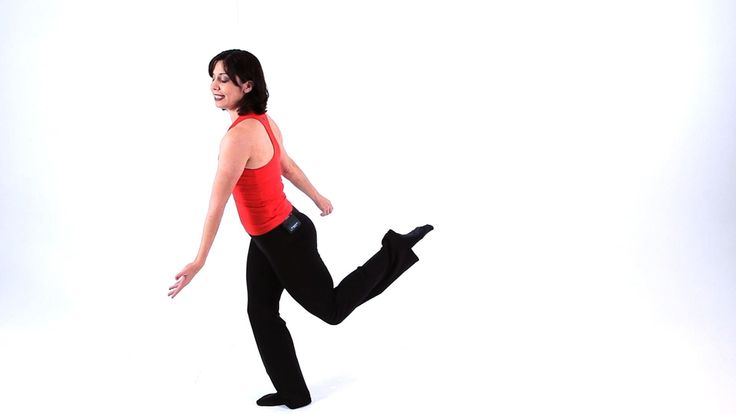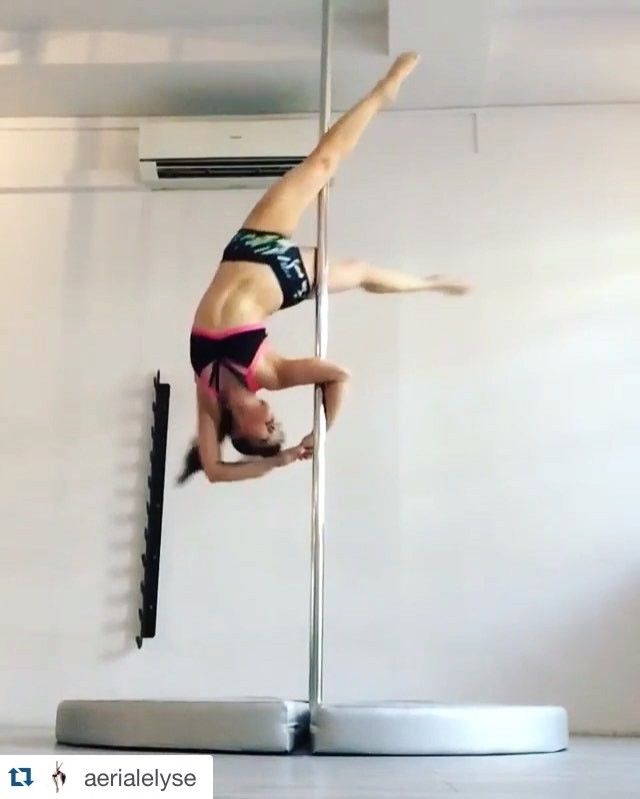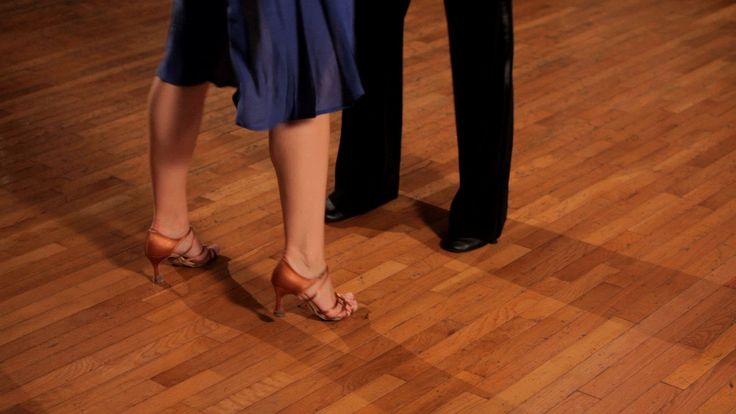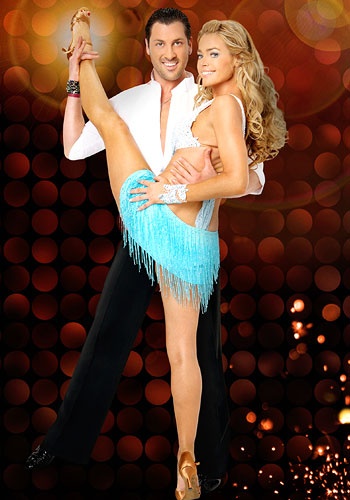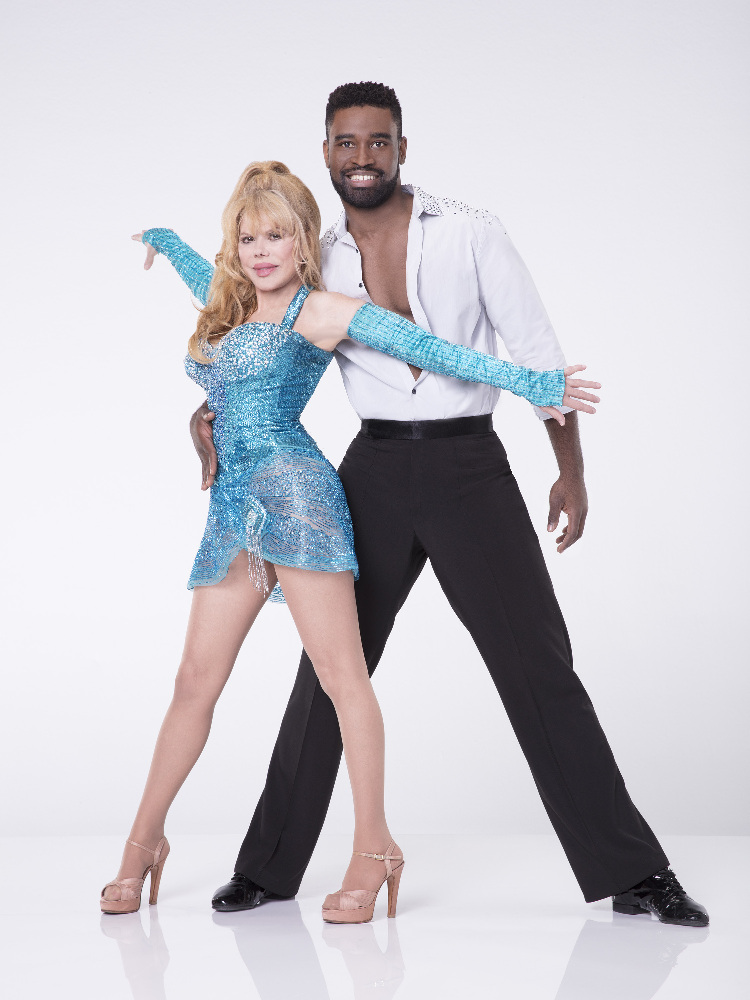How to make a belly dance face veil
How to Make Belly Dance Face Veils & Headdresses
Belly dance face veils and headdresses are not strictly necessary to put on a fine performance, but they help to add an element of mystery and mystique. Some belly dancers also believe that wearing a face veil lets them show their true beauty and expressions through their eyes, since the face is concealed. The fabrics you choose for your face veils and headdresses should complement the colors of your dancing ensemble; you might end up making more than one face veil or headdress to go with different dance costumes.
Things You'll Need:
- Measuring Tape
- Scissors
- 1/2-Inch Elastic
- Rigid Headband
- Needle And Thread
- Chiffon
Making the Face Veil
Measure your forehead from temple to temple by laying a flexible tape measure across your forehead.
Cut a square of chiffon or other lightweight fabric, 2 inches wider than the measurement you made. So, if your forehead is 8 inches from temple to temple, your fabric piece should be 10 inches wide by 10 inches high.
Hem the fabric square with a 1-inch hem on all sides.
Wrap the measuring tape around your head, at the same level you want the upper edge of the veil to sit, and note the measurement.
Cut a piece of 1/2-inch or narrower elastic that is 2 inches shorter than the measurement you just took. In other words if your head measures 25 inches around, you should cut the elastic to 23 inches long.
Stitch one end of the elastic to the upper right corner of your veil. Stitch the other end of the elastic to the upper left corner of your veil. Now you're ready to slip the veil over your face and secure it by placing the elastic loop behind your head.
Making Headdresses
Select a rigid headband that fits your head. This will be the base of your headdress.
Measure across the top of your head, from the top of one ear to the top of the other ear, with a flexible measuring tape.
Cut a piece of chiffon or other lightweight fabric that is as wide as your head measurement plus 2 inches, and 3 inches longer than you want the headdress to be.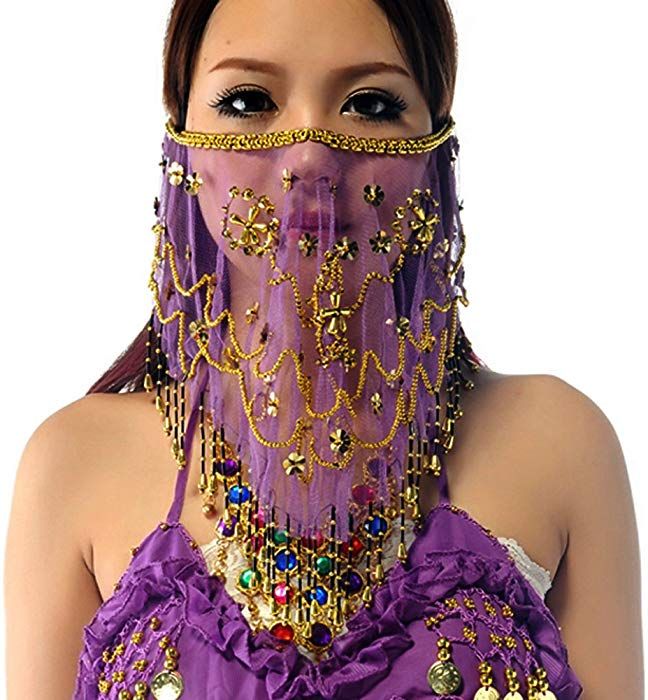 In other words if your head measured 15 inches across from the top of one ear to the top of the other ear, the fabric should be 17 inches wide, and if you want it to be 24 inches long when finished, the fabric you cut should be 27 inches long.
In other words if your head measured 15 inches across from the top of one ear to the top of the other ear, the fabric should be 17 inches wide, and if you want it to be 24 inches long when finished, the fabric you cut should be 27 inches long.
Hem the fabric with a 1-inch hem on all sides.
Wrap the front edge of the fabric around the headband and stitch it to the rest of the fabric, creating a fabric tube around the headband.
Secure a strip of elastic to each end of the headband, if you so desire, to help hold it in place on your head. Depending on what the headband is made of, you can either stitch the elastic into place or hot glue it to the outside edges of the headband.
Tip
Belly dance veils can be made of see-through fabric, to allow a dancer to still use facial expressions as part of the dance, or they can be made of solid fabric to add an element of mystery.
|
Ask the Costume Goddess:by Dina Lydia
The QuestionDear Costume Goddess: Could you tell me the measurement of the normal size veil? I can't afford to buy one, and my friend can make it for nothing. I am just belly dancing for my husband because it is our 7 year anniversary and I want it to be special. Can you help me? --Tabatha
The Costume Goddess RespondsDear Tabatha, Your husband is a lucky man! A "normal"-sized belly dancing veil is 3 yards long. For practice or for a beginner, synthetic chiffon is fine,
but I have to rhapsodize here about the exquisite floatiness
of real silk. The gauze (labeled 4.5mm) or featherweight silk
(5mm) is the lightest and floatiest. The 36" width is less
costly, of course, than the 45'". It is usually available
only in white and needs to be dyed, but silk dyes easily — I've
done this at home with several types of dye, including plain
old Rit. If you do this, remember that the silk, especially the
gauze, will shrink a bit, so buy 1/4 yd extra.
In this photo, Katia, an expert with veil work, is using
an extra-large rainbow-dyed veil. --The Costume Goddess
Additional Comments from ShiraLisa, a reader of my web site, sent me email after noticing the references to dye on my web site to offer some cautionary advice. She is majoring in costuming in college, and shares some important health warnings to offer about working with dye. According to Lisa, the popular easy to use kind of dye that
is sold in many craft stores contains a chemical that can cause
liver cancer when exposed to it over long periods of time. The
dye never really sets. When worn next to the skin in humid weather
or when sweating, the moisture causes it to absorb into the skin.
Because there is nothing to regulate dyeing products, this company was
able to change its formula very slightly to keep it from registering
as toxic, but it doesn't change the effects. For this reason it is also very important to read and perform all of the safety measures when dyeing and setting colors. These commonly include wearing a dust mask and latex gloves. Thank you, Lisa, for sharing this important health information!
Related ArticlesOther articles on this web site related to veils include:
About the Costume Goddess
Costume Goddess PhotosTo view a photo gallery featuring pictures of Dina, costumes she has designed, and her friends, either click on the choices below or visit her web site:
The contents of this page are copyrighted 2009 by Dina Lydia. All rights reserved. Unauthorized duplication is forbidden.
Copyright NoticeThis entire web site is copyrighted. All articles, images, forms, scripts, directories, and product reviews on this web site are the property of Shira unless a different author/artist is identified. Material from this web site may not be posted on any other web site unless permission is first obtained from Shira. Academic papers for school purposes may use information from this site only if the paper properly identifies the original article on Shira.net using appropriate citations (footnotes, end notes, etc.) and bibliography. Consult your instructor for instructions on how to do this. If you wish to translate articles from Shira.net into a language other than English, Shira will be happy to post your translation here on Shira.net along with a note identifying you as the translator. This could include your photo and biography if you want it to. Contact Shira for more information. You may not post translations of Shira's articles on anybody else's web site, not even your own. If you are a teacher, performer, or student of Middle Eastern dance, you may link directly to any page on this web site from either your blog or your own web site without first obtaining Shira's permission. Click here for link buttons and other information on how to link.
|
| Polina Reg. | Good day to all! |
| Owl Reg. | Polina, I worked a lot on a knitting machine with Lurex thread. Usually it is a thin flat lurex in 5 or more additions + a lowercase thread or any other for a hook, probably something thicker will do. . As for elasticity, so, in my opinion, everything that is crocheted stretches, If necessary, you can put it on a lining of skin-colored tights. good luck |
| Polina Reg. | Owl, hello! Thanks for the answer. What kind of thread is suitable for this? What materials should be in it and in what ratio? Cotton, elastane, or something else? Advise |
| Sova Reg. | Good, what do you have there! |
| Arabica Reg. | Polina, our girl at the dance brought a crocheted belt, there are also beads with monists. I can take a photo. Many, following the example, have already been linked with us. I also tied it, only the monist remains to be sewn on ;-) |
| Marusya Reg. Awards: 1 | Of course, take a picture, pliiiiz! |
| Afonea Reg. Awards: 1 | Oh girls, I want that belt too! In general, I really like to have an original belt for each item, but there really is nothing to buy from us. |
| Arabica Reg. | Well, it's more like a rehearsal belt to make the coins feel |
| Brunya Reg. | and this is my new scarf belt. coins were not supposed - the teacher does not allow ... but the sequins also look good
|
| Magic Pen Reg. | Oza, you got very beautiful belts, you can't take your eyes off. And you do not tell me how you attached the coins. Are they already attached to the finished product (tied) or tied? |
| Katerina Kes Reg. | Thank you Oza! |
| amori Reg. | I saw very good. beautiful belly dance belts. Type of knitted scarf, mesh, with glass beads. Does anyone have a description? |
| Fata Morgana Reg. | I saw in the store, in my opinion there is an ordinary fillet and sequins. |
| amori Reg. | I saw at the girl's, in my opinion there is a bugle strung there. I didn’t immediately consider it, but now I’m thinking about it ...) |
| Pretty Lady Reg. | I saw such scarves in advertisements in "glossy" magazines. |
A weeping bride or two attempts to have a successful wedding
Tags
Bouquet Groom Marriage Ring Husband Bride Wedding CeremonyIt just so happens that in my lifetime I can count two whole terrible weddings. It would seem that if the wedding day does not start very well, it is better to cancel everything right away. But innate perseverance and upbringing did not allow him to yield to the signs of fate. Unfortunately.
© Depositphotos
Let me start by saying that I have never dreamed of a wedding. Unlike other girls, I preferred to avoid unnecessary attention. But when it comes to an event like a wedding, personal preferences go by the wayside.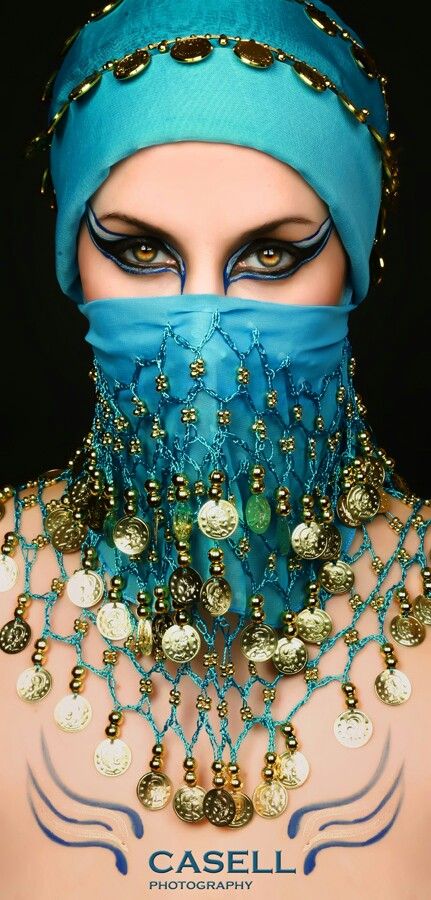 After all, everything “should be like with people.”
After all, everything “should be like with people.”
Wedding № 1. Crying bride and accident
Dress and veil had to be rented. Shoes and jewelry left over from graduation. The only pleasant thing I remember from that wedding was a bouquet from my florist friend.
And here I am walking along the red carpet of the sad registry office to the frustrated march of Mendelssohn. Relatives are around, and ahead of me is a tired-looking woman with a “challah” and her mournful speech about ships, voyages and family life. I had the feeling that the ship of my mind was swallowed by the fog.
© Depositphotos
After the registry office, we went to local attractions. It was raining that day. The role of the driver was a witness who took the car from his father. After a couple of kilometers we had an accident. Fortunately, of all of us, the bouquet suffered the most, which scattered around the salon, and I, quietly sobbing, gathered the flowers into a bouquet. The first symbolic picture of adult life, one might say.
The first symbolic picture of adult life, one might say.
Picking up my skirt, I stepped out into the rain and saw a line of slowing cars trailing behind us. If it were today, most people would grab their cameras and start filming what is happening - this kind of content is not often seen. Instead, I became the subject of sympathetic looks. And I didn't care what they saw: a crying bride in the rain holding the remains of a bouquet in her hand.
© Depositphotos
As a result, the husband and the witness with his girlfriend went to the police station. And the last thing I remember is how the witness and I were driven home in a police car. Luckily, there was no feast.
Wedding № 2. Belly dancing and other registry offices
The second time I decided on such an adventure at the age of 25. This time I decided that everything would be my way, which is why I met a lot of misunderstanding from everyone. The dress I wanted was not the one that was offered to me (that is, the same as the previous one).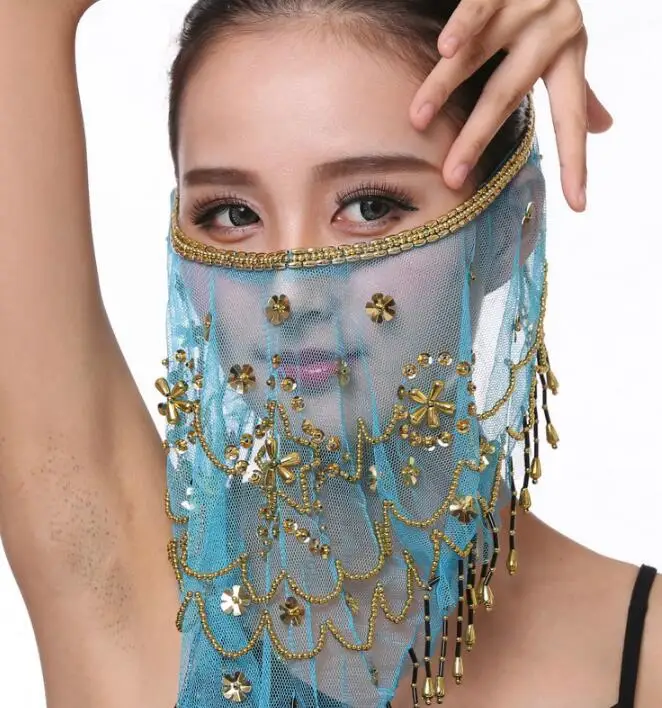
I had to demand a ring to my liking in a jewelry store in defiance of an obsessive saleswoman. Thank you, it was already subtle and elegant. Now give me that wide one.
The bridesmaid offered to sign in the same registry office as last time. After all, it's more convenient for everyone. But no. I've been there twice already and going back a third time is somehow embarrassing.
© Depositphotos
This time we had a limousine with a chauffeur who claimed to have recently driven Leonardo DiCaprio in it. I just nodded. The main thing is that we arrive normally, to which the driver looked at me in bewilderment.
The next registry office turned out to be much more presentable than the previous one. The woman with the folder was already without a monumental hairstyle and much friendlier, the music played on the record. I was the one who broke the rules. At the moment when I was supposed to put the ring on the groom's finger, it fell to the floor.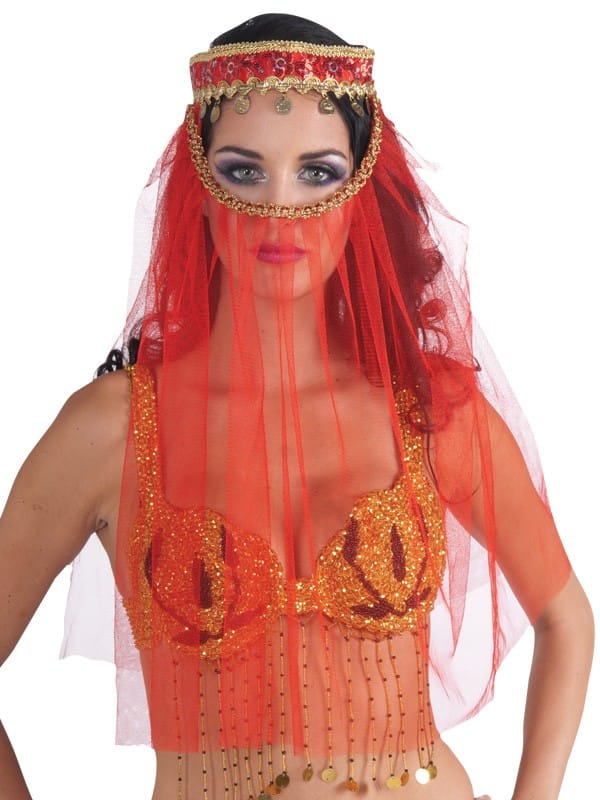
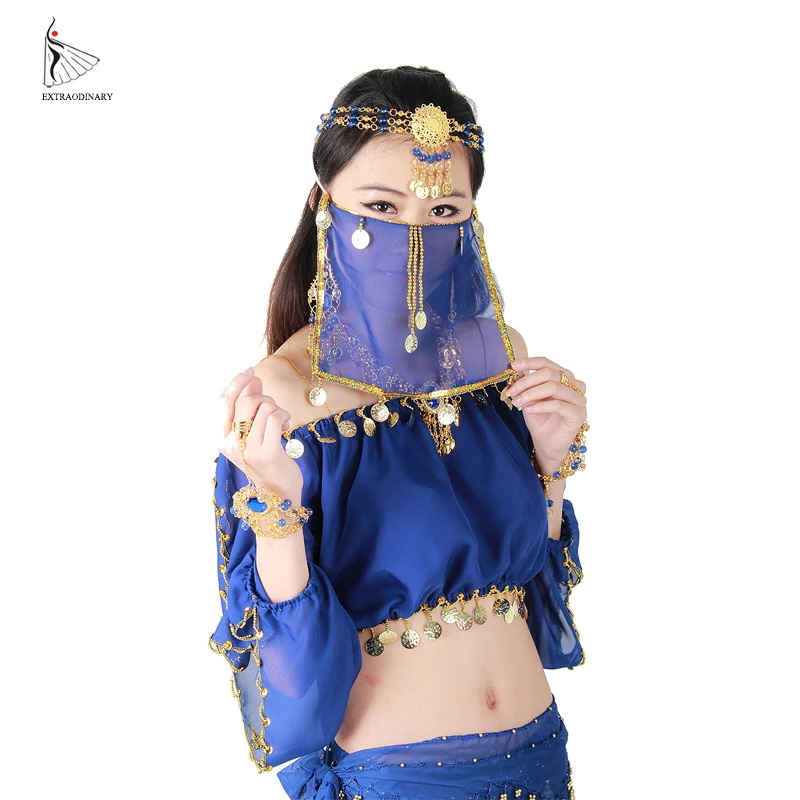
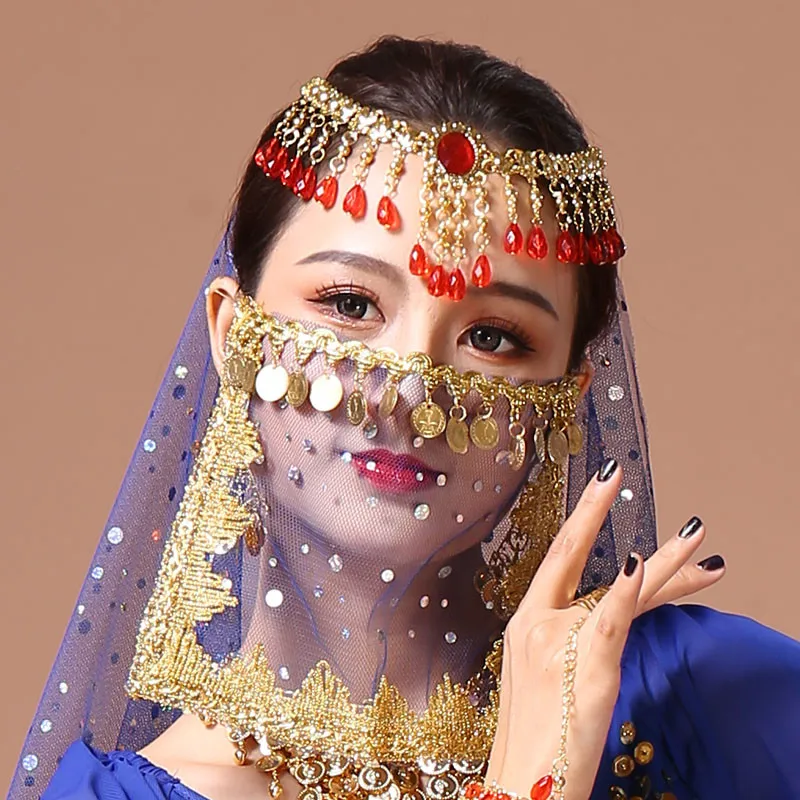 But I recommend using your height as a guide. When the veil is
draped around your neck, the ends should be an inch or two off
the floor. If you are short (like me), that would be a little
less than 3 yards. Some dancers use the 45" width or more,
but if you're short, you might prefer prefer 36-40 inches.
But I recommend using your height as a guide. When the veil is
draped around your neck, the ends should be an inch or two off
the floor. If you are short (like me), that would be a little
less than 3 yards. Some dancers use the 45" width or more,
but if you're short, you might prefer prefer 36-40 inches.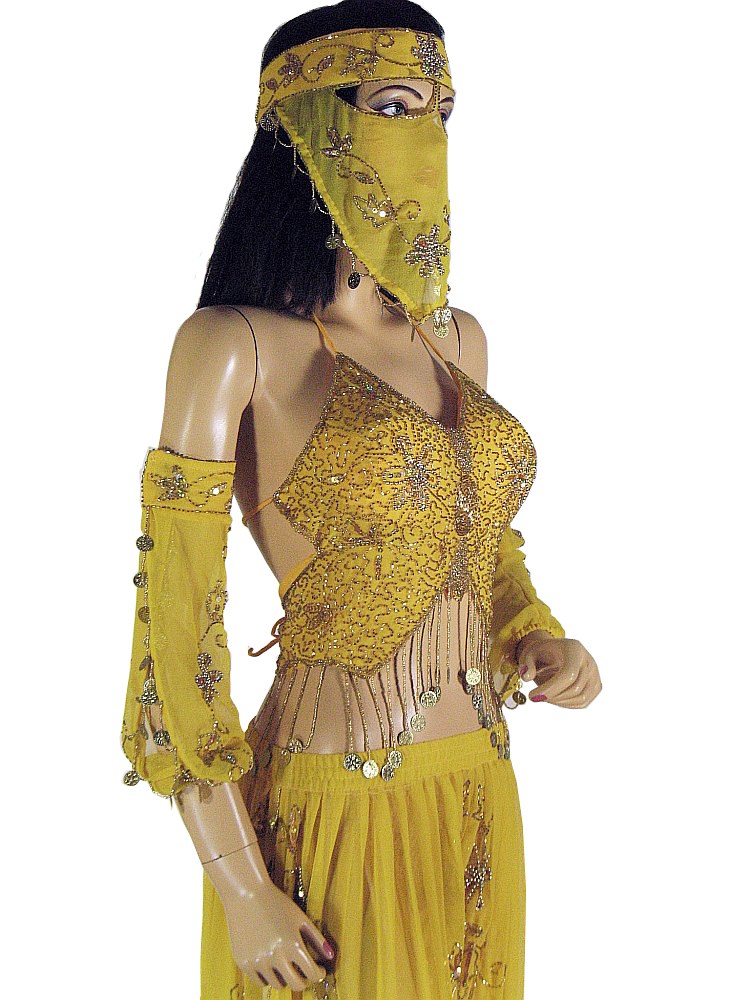
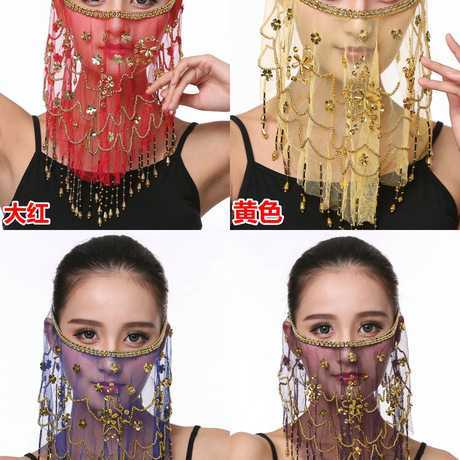
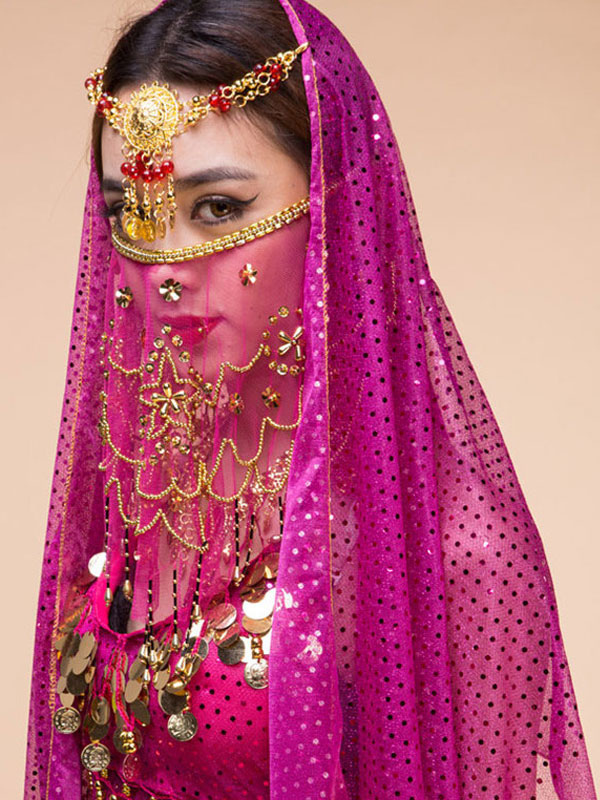 For a veil which
brushes the skin only fleetingly, there should be no problem,
but it is a risk that people should be aware of.
For a veil which
brushes the skin only fleetingly, there should be no problem,
but it is a risk that people should be aware of.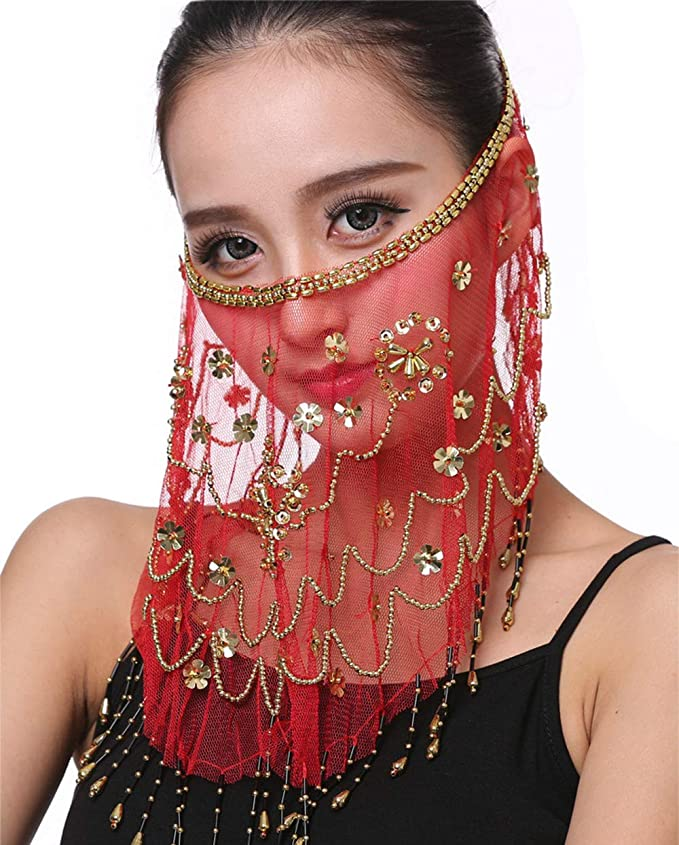 Describes how to make a rectangular veil.
Describes how to make a rectangular veil.
 Now the pleasure of wearing her own designs, and
seeing others wear them, offers as much pleasure as dancing. She's
become expert as well in altering those troublesome ready-made
Egyptian costumes, and modifying designs to flatter individual
figures.
Now the pleasure of wearing her own designs, and
seeing others wear them, offers as much pleasure as dancing. She's
become expert as well in altering those troublesome ready-made
Egyptian costumes, and modifying designs to flatter individual
figures. costumegoddess.com.
For reviews here on Shira.net of some of her books, see:
costumegoddess.com.
For reviews here on Shira.net of some of her books, see: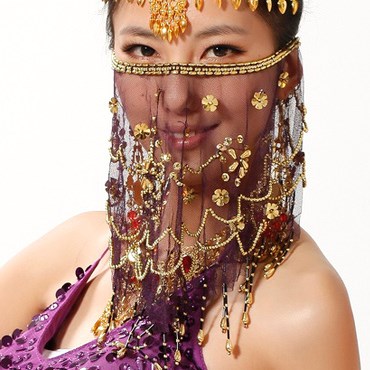 S. Tribal costuming.
S. Tribal costuming. 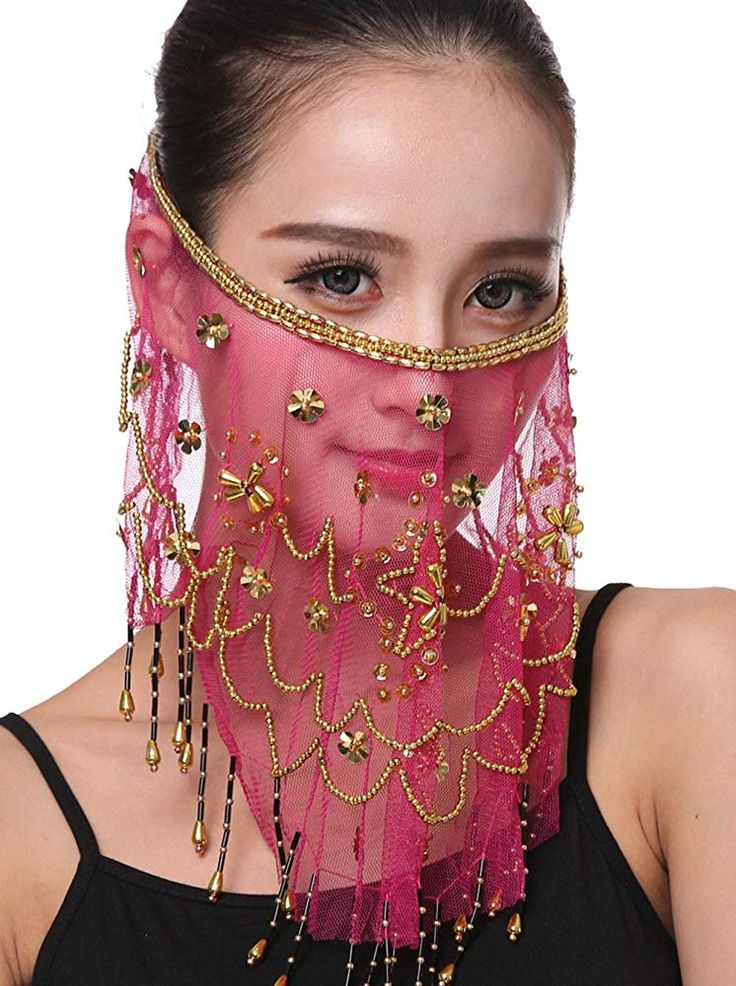 All rights reserved.
All rights reserved.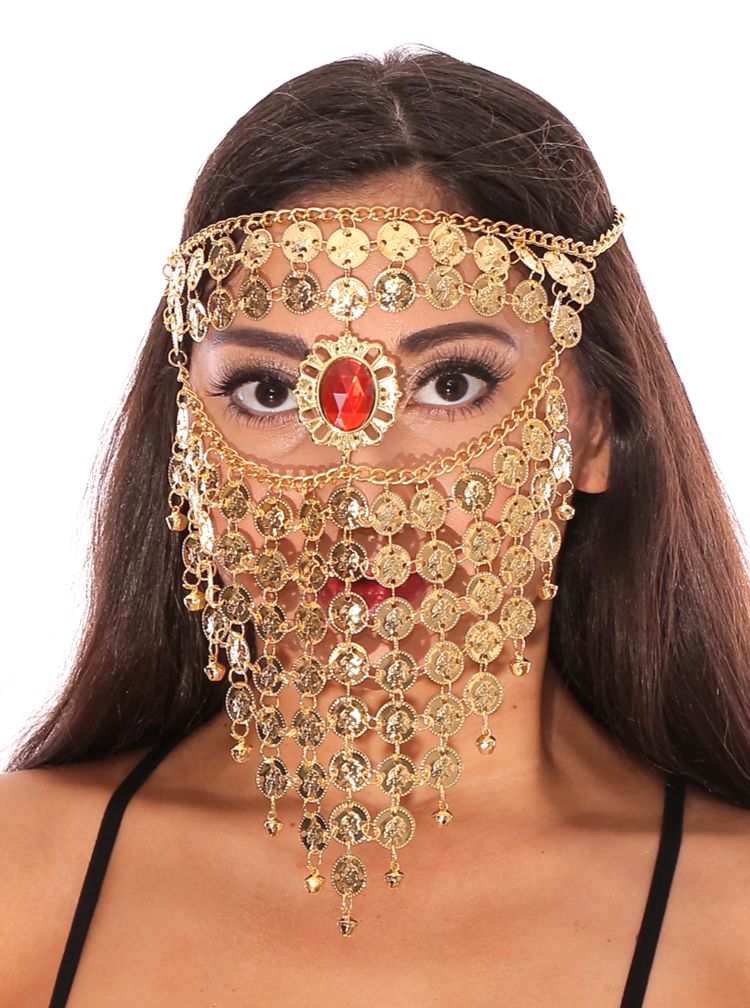

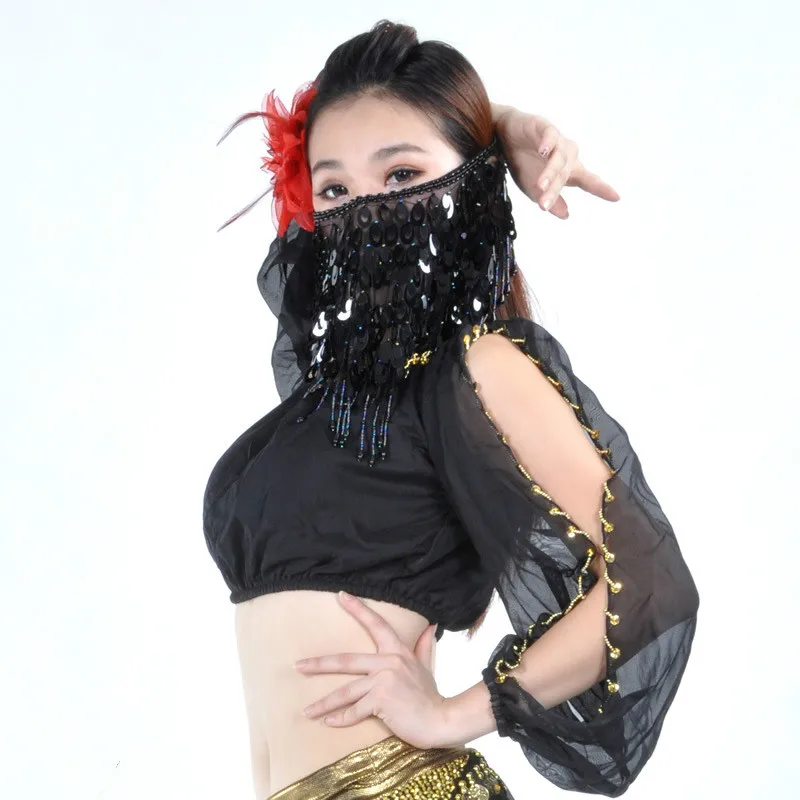
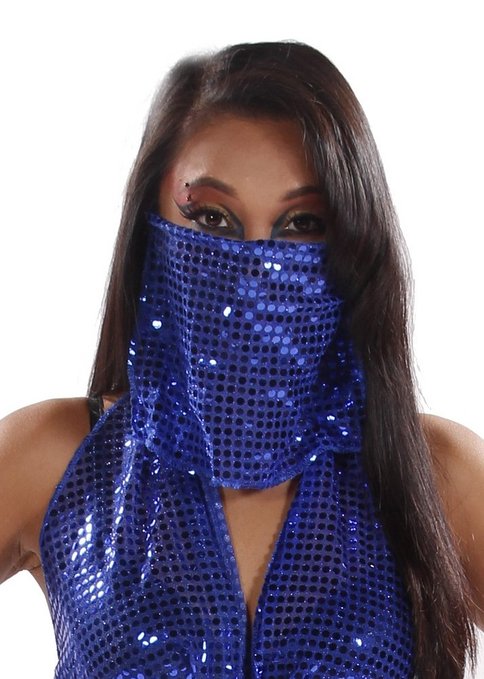


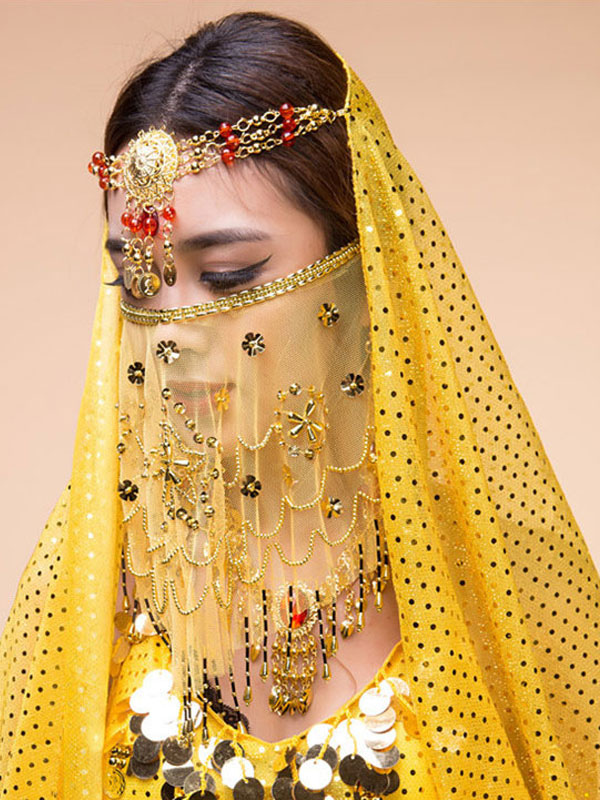 It also seems to me that beads are strung on the yarn. Along the short edges, the kerchief was decorated with a fringe of yarn of the same color as the kerchief itself.
It also seems to me that beads are strung on the yarn. Along the short edges, the kerchief was decorated with a fringe of yarn of the same color as the kerchief itself. 

